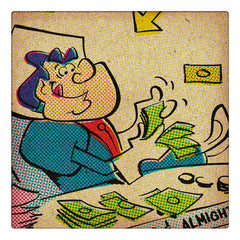Spaceman Jax – Ahead of its time?

The classic 1960s characters from animation and comics dealt with some of the same issues we do today.
It’s no surprise that a show set in the future might look familiar today some fifty years later. Spaceman Jax and the Galactic Adventures was set in the Star Year 6354 ¾, so we’ve still got a long way to go to catch up with them. None of us are living aboard our own spaceships yet or visiting several planets across the galaxy in a single day, but we do have small robots who can vacuum for us while we’re at work as well as pretty fancy telecommunication systems that we can fit in our pockets. But it might just be some of the show’s ideas about society or the environment that really look familiar to today’s audiences.
In Spaceman Jax’s galaxy, most everything runs on energy produced by zandabite crystals. Jax himself makes his living shipping the crystals, and it’s pretty clear there aren’t too many alternatives. But the show also gave us occasional glimpses of the dark reality of that energy dependence. In his rather somber back-story, Jax’s home planet Tiberion 3 is destroyed in a tug-of-war over the planet’s precious zandabite mines. This certainly seems to foreshadow the oil crises we’ve seen in recent decades, as well as environmental fears for the fate of our own planet as our appetite for natural resources increases.
Maybe most surprising, is how they managed to produce a show with a greedy capitalist bad guy at the height of the cold war. Tarloc owns just about everything in the galaxy, conveniently – and cost-effectively – naming everything after himself. He takes an interest in planets either because of their resources, or for their potential markets, and with a few hilarious exceptions, doesn’t care much about anyone else.
Still, Tarloc was never shown enjoying his wealth and he lived pretty frugally, and for 1960s audiences, maybe there was something a little suspicious in taking no pleasure in success.
As far as social issues go, Spaceman Jax and the Galactic Adventures tackled as many as any other cartoon at the time – which is to say not at all. You could argue that Spaceman Jax was one of several shows in the 1960s to hint at single parenthood, like Family Affair or The Courtship of Eddie’s Father, and some have speculated that the character of Red was an effort to address race issues on the show – but I think that gives the studio far too much credit in retrospect.
Of course, they might not have been thinking at all about issues like natural resources or concentration of wealth – sometimes a pipe is just a pipe after all. But it’s interesting to see that there is still plenty for today’s audiences to get out of the show, even if we’re only seeing the reflections of our own world.